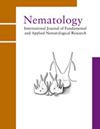实时逆转录聚合酶链反应检测活的苍白球菌
IF 1.2
4区 生物学
Q2 ZOOLOGY
引用次数: 0
摘要
苍白球藻是世界范围内马铃薯的主要害虫。在日本,为了根除苍白球菌,已在受感染的田地里实施了控制措施。为了确定控制措施的必要性,需要检测活的苍白球菌。然而,在日本进行的名为“杯状试验”的常规接种试验很耗时,而且针对DNA的常规PCR方法可以检测死亡个体。在本研究中,我们开发了一种基于插入物的RT-qPCR方法来快速检测活的苍白球菌。我们设计了苍白球菌Y45F10D.4基因部分cDNA序列的引物组。该引物组成功扩增了所有受试群体的Y45F10D.4mRNA,与其他物种没有任何交叉反应。RT-qPCR方法检测到至少3.9个苍白球蛋的RNA,并且在从活蛋中提取的RNA浓度与Ct值之间观察到显著的负相关性。此外,在用1,3-二氯丙烯处理的苍白球中没有观察到RT-qPCR扩增,表明该方法特异性地检测到活的苍白细胞。然后,我们使用24个土壤样本比较了杯形试验和RT-qPCR方法的检测灵敏度,结果表明RT-q聚合酶链式反应方法的检测敏感性高于杯形试验。RT-qPCR方法能够快速可靠地检测活的苍白球菌。本文章由计算机程序翻译,如有差异,请以英文原文为准。
Species-specific detection of viable Globodera pallida using real-time reverse transcription PCR
Globodera pallida is a major pest of potatoes worldwide. In Japan, aiming at eradication of G. pallida, control measures have been implemented in infested fields. To determine the necessity of control measures, the detection of viable G. pallida is required. However, the conventional inoculation test performed in Japan, named the ‘cup test,’ is time-consuming, and conventional PCR methods targeting DNA can detect dead individuals. In this study, we developed an intercalator-based RT-qPCR method for the rapid detection of viable G. pallida. We designed a primer set for the partial cDNA sequence of the Y45F10D.4 gene of G. pallida. This primer set successfully amplified Y45F10D.4 mRNA of all tested G. pallida populations without any cross-reactions with other species. The RT-qPCR method detected RNA corresponding to a minimum of 3.9 G. pallida eggs, and a significant negative correlation was observed between the concentrations of RNA extracted from viable eggs and the Ct values. In addition, no amplification by RT-qPCR was observed in G. pallida treated with 1,3-Dichloropropene, indicating that this method detected viable G. pallida specifically. We then compared the detection sensitivity between the cup test and RT-qPCR method using 24 soil samples, and the results showed that the detection sensitivity of the RT-qPCR method was higher than that of the cup test. The RT-qPCR method enabled the rapid and reliable detection of viable G. pallida.
求助全文
通过发布文献求助,成功后即可免费获取论文全文。
去求助
来源期刊

Nematology
生物-动物学
CiteScore
2.60
自引率
33.30%
发文量
67
审稿时长
3 months
期刊介绍:
Nematology is an international journal for the publication of all aspects of nematological research (with the exception of vertebrate parasitology), from molecular biology to field studies. Papers on nematode parasites of arthropods, and on soil free-living nematodes, and on interactions of these and other organisms, are particularly welcome. Research on fresh water and marine nematodes is also considered when the observations are of more general interest.
Nematology publishes full research papers, short communications, Forum articles (which permit an author to express a view on current or fundamental subjects), perspectives on nematology, and reviews of books and other media.
 求助内容:
求助内容: 应助结果提醒方式:
应助结果提醒方式:


